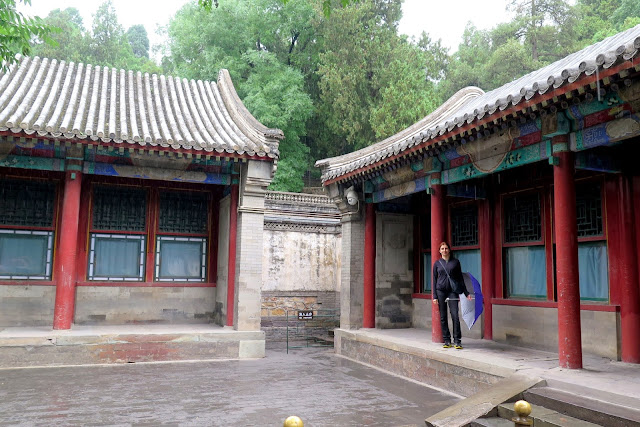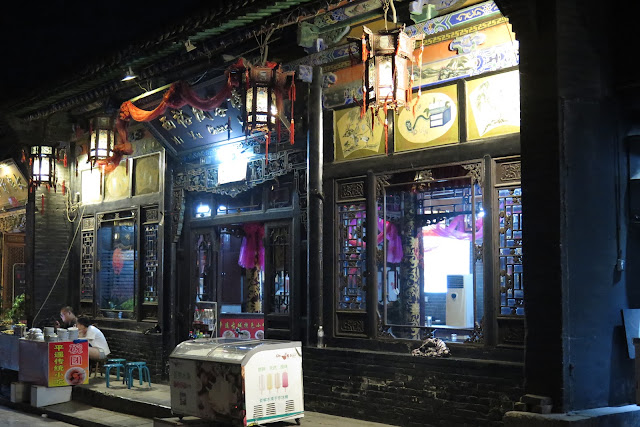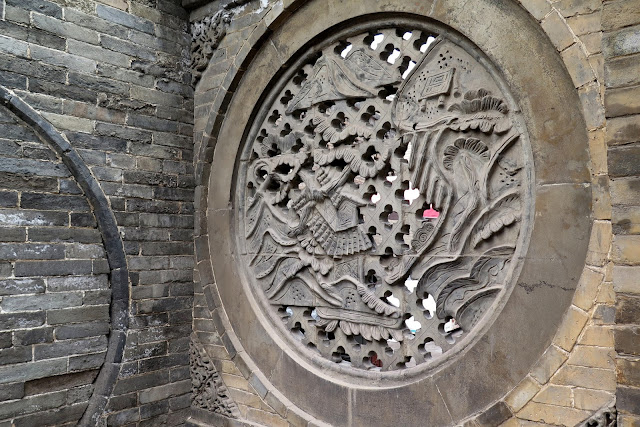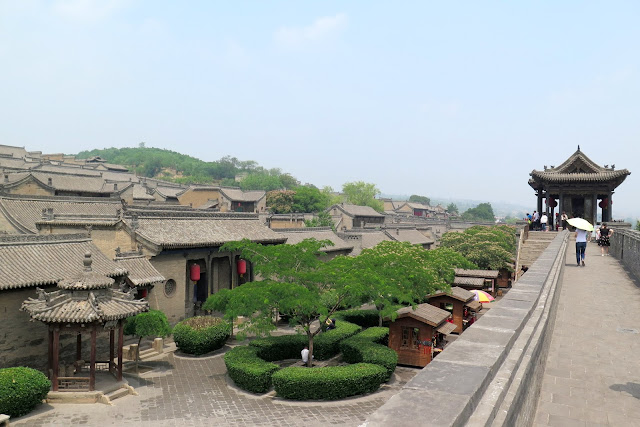Day 4 - continued
We work our way out of the city.
To see one of the highlights of the trip .
Up on them thar hills...
Zoom...
There you go ...
First we run the gauntlet .
Of shops...
Some walk...
We take the cable car...
Ascending...
Such a traditional view .
Its a long walk for the foolhardy brave :-P
What a view .
Mutianyu is a section of the Great Wall of China located in Huairou County 70 km northeast of central Beijing.
The Mutianyu section of the Great Wall is connected with Jiankou in the west and Lianhuachi in the east. As one of the best-preserved parts of the Great Wall, the Mutianyu section of the Great Wall used to serve as the northern barrier defending the capital and the imperial tombs.
First built in the mid-6th century during the Northern Qi, the Mutianyu section is older than the Badaling section of the Great Wall. During the Ming dynasty, under the supervision of General Xu Da, construction of the present wall began, building over the previous wall
In 1404, a pass was built in the wall. In 1569, the Mutianyu Great Wall was rebuilt and till today most parts of it are well preserved. The Mutianyu Great Wall has the largest construction scale and best quality among all sections of Great Wall.
Built mainly with granite, the wall is 7–8.5 metres high and the top is 4–5 metres wide. Compared with other sections of Great Wall, Mutianyu Great Wall possesses unique characteristics in its construction.
- Watchtowers are densely placed along this section of the Great Wall - 22 watchtowers on this 2,250-metre-long stretch.
- Both the outer and inner parapets are crenelated with merlons, so that shots could be fired at the enemy on both sides - a feature very rare on other parts of the Great Wall.
The Mutianyu Pass consists of 3 watchtowers, one big in the centre and two smaller on both sides. Standing on the same terrace, the three watchtowers are connected to each other inside and compose a rarely seen structure among all sections of Great Wall
There are three methods of ascent and four methods of descent to choose from. Besides utilizing 4000+ steps, visitors may also choose between a two-rider chairlift or four-rider gondola lift up from the foothills to the level of the wall, which runs along the ridges above. These lifts may also be used to descend. Another feature of the wall at Mutianyu is an alternate method of descent by single-rider personal wheeled toboggan. This allows single riders to descend from the wall to the valley on a winding metal track
What a view !!!!!!!!!!!!!!!!!!!!!
A comprehensive archaeological survey, using advanced technologies, has concluded that the Ming walls measure 8,850 km (5,500 mi)
Amazing .
Standing here is surreal .
Bucket list ticked .
We're very lucky to have this all to ourselves .
Some days its like a fish market .
The very next day this whole section was closed to tourist...
Due to heavy rains .
It was closed for 3 days .
We are lucky to be able to experience this .
One of the many watchtowers .
So cool .
A new member of our family.
We enjoy the sights...
...and take in the views .
Amazing .
After a long day we come here .
For a traditional Chinese show .
Novices limbering up .
The show was nice .
But no where as good as the show i saw during my ride in Jinghong .
Still fun though . A nice way to end the day .
Day 5
We visit the Summer place. During summer...
And it rains .
Nothing like Malaysian rains though .
The Summer Palace is a vast ensemble of lakes, gardens and palaces in Beijing, China. It was an imperial garden in Qing Dynasty. Mainly dominated by Longevity Hill and Kunming Lake, it covers an expanse of 2.9 square kilometres (1.1 sq mi), three-quarters of which is water.
Cool huh .
Many small buildings make up the whole .
Wet bunny.
The rains stop soon though .
A big rock :-)
The origins of the Summer Palace date back to the Jurchen-led Jin dynasty in 1153, when the fourth ruler, Wanyan Liang (r. 1150–1161), moved the Jin capital from Huining Prefecture (in present-day Acheng District, Harbin, Heilongjiang) to Yanjing (present-day Beijing). He ordered the construction of a palace in the Fragrant Hills and Jade Spring Hill in the northwest of Beijing.
Kunming Lake is the central lake on the grounds of the Summer Palace in Beijing, China. Together with the Longevity Hill, Kunming Lake forms the key landscape features of the Summer Palace gardens.
With an area of 2.2 square kilometres (0.8 sq mi), Kunming Lake covers approximately three quarters of the Summer Palace grounds. It is quite shallow, with an average depth of only 1.5 metres (5 ft)
Kunming Lake is designed to represent the traditional Chinese gardening practice of "one pond, three hills
The largest bridge on Kunming Lake is the 17-Arch Bridge that connects the eastern shore with South Lake Island, representing Penglai
This corridor goes all along the lake .
The Long Corridor is a covered walkway in the Summer Palace in Beijing, China. First erected in the middle of the 18th century, it is famous for its length (728 m) in conjunction with its rich painted decoration (more than 14,000 paintings
I get a prize at the end :-)
Nice gardens .
Tower of Buddhist Incense Located right in the centre of the front hill of Longevity Mountain. The tower was originally meant to be a nine-storey Buddhist pagoda built to resemble the Yellow Crane Tower. The Qianlong Emperor ordered the construction to be stopped just after the eighth storey was built.
The tower was built on a 20-metre-tall stone base, measures three stories and 41 metres in height, and is supported by eight ironwood pillars.
Beautiful no...
The views are great...
And it will be even better in the sunshine .
We're in the center of the grounds .
Jade Spring Hill is located to the west of the Summer Palace in Beijing, China. It was also formerly known as Jingming Palace or Jingming Garden. It is named after the Jade Spring. It is the location of the Xiangji Temple, the Yufeng Pagoda, the Jinxing Palace and the Furong Palace. Jade Spring Hill is the villa area of the Central Military Commission (CMC) today, and is not open to the public.
A long way to go .
Nice huh .
A really tall tower .
The Jade Peak Pagoda is a Chinese pagoda on Jade Spring Hill in an Imperial Garden, Jingming Yuan , in Beijing, China. The site was originally an imperial retreat during the Liao Dynasty (907–1125) and was renovated by the Qianlong Emperor in 1752
The pagoda is 30 metres (98 ft) high, has seven stories, has an octagonal base and frame, and is built of brick and stone. Its design imitates the Cishou Pagoda of Jiangtian Temple on the Golden Hill, near Zhenjiang, Jiangsu. It was designed to appear similar to wooden structures. All eight sides on every level feature doors and windows. The walls are thick, and the interior features a wide spiral stone staircase. Niches in the walls of each storey include carved couplets by the Qianlong Emperor and once held a set of bronze Buddhas.
An old residence .
Now a souvenir shop .
Colourful .
An Indian in China :-P
The Marble Boat , also known as the Boat of Purity and Ease, is a lakeside pavilion on the grounds of the Summer Palace in Beijing, China.
It was first erected in 1755 during the reign of the Qianlong Emperor. The original pavilion was made from a base of large stone blocks which supported a wooden superstructure done in a traditional Chinese design.
The pavilion is 36 metres (118 ft) long. It stands on the northwestern shore of Kunming Lake, near the western end of the Long Corridor.
The pavilion has a sophisticated drainage system which channels rain water through four hollow pillars. The water is finally released into the lake through the mouths of four dragon heads
We finally reach the end of the palace...
But not of the grounds .
The Jade Belt Bridge , also known as the Camel's Back Bridge, is an 18th-century pedestrian Moon bridge located on the grounds of the Summer Palace in Beijing, China. It is famous for its distinctive tall thin single arch.
My baby in China .
A long day of touring .
After lunch we head here .
Chinese countryside .
This is a fast train .
Gorges .
Pingyao town .
That's a train station...huge .
Our room in an ancient hotel building
During our travels Han and i got to see the ancient Chinese towns at night. Amazing .
I wanted to give my wife that experience .
Here we go ...
So cool huh.
You must see the ancient towns both at day and night .
Dali ,Lijiang ,Shangrila and now Pingyao .
She loved it .
The purpose of life is to have as much experiences as we can with the time we are given .
We try .
Nice huh .
We will also tour in the day time but with the lights....
...its surreal .
We walk along and take in the sights .
From here on in ...
..no more rain .
In fact we had only one day of rain .
Lucky .
Its cold though .
All the houses have courtyards .
Nice huh .
This is ours.
Back for dinner and zzzzzzz
Day 6
I explore the hotel in the morning .
Lots of nooks and crannies .
And so colourful .
A Moon Gate is a circular opening in a garden wall that acts as a pedestrian passageway, and a traditional architectural element in Chinese gardens. Moon Gates have many different spiritual meanings for every piece of tile on the gate and on the shape of it. The sloping roofs of the gate represent the half moon of the Chinese Summers and the tips of the tiles of the roof have talismans on the ends of them. Chinese Gardens are often used as a display of class and beauty in many different Western Cultures. The purpose of these gates is to serve as a very inviting entrance into gardens of the rich upper class in China. The gates were originally only found in the gardens of wealthy Chinese nobles.
So cool to be here .
We start our tour .
On bike trips Han and i do everything ourselves .
When my wife is here, we are guided ,driven and escorted everywhere .
One of the city gates .
Cars are not allowed in the city...
So we have a nice walk to our ride .
Still early in the morning .
After a short drive we reach here .
The Shuanglin Temple is a large Buddhist temple in the Shanxi Province of China. It is situated in the countryside of Qiaotou village about 6–7 kilometres (3.7–4.3 mi) southwest of the ancient city of Pingyao. It is among the many cultural monuments located in the Pingyao, which is a UNESCO World Heritage site inscribed in 1997. The temple is protected by the state administration.
Founded in the 6th century, the temple is notable for its collection of more than 2,000 decorated clay statues that are dated to the 12th-19th centuries. Its original name was Zongdu but it was renamed during the Northern Song Dynasty period as Shuanglin. It is nicknamed the museum of coloured sculptures. Most of them are dated to the period of the Song, Yuan, Ming and Qing dynasties.
Even a temple needs walls for defence .
Locals .
Through the gate ....
We enter the first courtyard .
Deities .
The Buddhist temple was founded in 571 A.D. during the second year of the Wuping period of the Northern Qi Dynasty. However, the extant buildings date to the Ming and Qing dynasties. It is notable for its collection of over two thousand decorated clay statues dating from the 12th-19th centuries
Shuanglin Temple was refurbished during the cultural revolution of the 20th century under a programme which revived secular culture. It is one of the five sites identified in the city's preservation area of cultural relics which has undergone several renovations
In Pingyao's tortoise-shaped city plan, which is characterized by many coloured art sculptures, the Shuanglin Temple is rated as the city's third treasure
The sculpted figures are displayed in a very systematic manner, in ten halls. The temple complex appears like a fortress as it has a high compound wall with a gate. The ten halls are arranged within three courtyards
The 2nd courtyard .
The number of coloured sculptures are reported to be 2,052, out of which 1,650 are reported to be extant. The height of the sculptures varies between 0.3–3.5 metres (1 ft 0 in–11 ft 6 in)
Inner temples .
Eighteen sculptresses are in the Arhat hall . These are sculpted as noble figures with amicable facial expressions. The garments are similar to the Cao Jiaxiang’s style and have received wide acclaim. The carved garments are tight fitting shirts over loose robes with broad sleeves. The most striking figure among the sculptures in the Arhat hall is that of the holy Guanyin style of sculpting which was popular during the later period of Chinese Buddhism. The gilded sculpted image of Bodhisattva of this period is shown in a cross-legged pose seated on a lotus. A Sumeru throne is sculpted below this image and is fixed over figures of mighty men. The statue is carved in a halo
Thousands of sculptures .
Ponds :-)
From here...
We go here .
Bodhisattva Hall, called the Pusa Ting , has a thousand-armed Guanyin. The ceiling in this hall contains depictions of a guard in the form of three-clawed round and bellied figure, and is painted green. The Bodhisattva hall has the sculpture of a young, attractive looking woman said to represent the Bodhisattva, which is sculpted with many hands. The clothing is very rich and ornaments decorate the Bodhisattva. The twenty or more arms of the Bodhisattva are well-sculpted, of very fair skin, with hands set behind the head and on torso.
Lots more figurines .
480 sculptures of Bodhisattva's.
More temples all around .
More depictions of Buddha .
Ornate ceilings .
Garuda ???
After all the temples we walk the compound walls .
Its quite big .
We reach the first courtyard .
Memories .
A last look ...
Past the entry decor...
And on to our next destination .
We're going to see a family compound...
How big could it be ??
We park at the base and walk.
That's the entry way .
Gardens at the front .
Its as big as a small town .
Wang's Compound is located in Jingsheng Town , Lingshi County , 35 kilometers (about 22 miles) from Pingyao Ancient City and 140 kilometers (about 87 miles) from Taiyuan City , Shanxi Shanxi Province
The compound occupies a total area of 150,000 square meters (about 179,399 square yards), of which 45,000 square meters (about 53,820 square yards) has been declares as a provincial protective cultural relic
Wang's Compound is not only an example of residential architecture, but also a museum of architectural art. Its sculptures of stone, wood and brick can be found everywhere in the courtyard. The crafts are refined and exquisite. Today, the architectural groups open for viewing are Gaojia Ya, Hongmen Bao, Chongning Bao, etc. Altogether there are 231 courtyards and 2,078 houses
2078 houses !!!!!
East Courtyard, informally called Gaojia Ya, was built during the reign of Emperor Jiaqing (1796-1820) of the Qing Dynasty. It was open to the public as the Art Hall of Chinese Residences on August 18th, 1997. The complexity of the structures will make you feel like you are moving through a labyrinth. It is a cluster of courtyards, each with its own kitchen yard and private school yard
In the middle sector are two main courtyards and Beiwei Yard. In front of the main yards is a long alleyway measuring 127 meters (about 417 feet) in length and 11 meters (about 36 feet) in width. To the northeast is a small side-yard while in the southwest there is a large side-yard. At the four sides of the East Courtyard there are four gates; east gate (to the east of the long alleyway), south gate (in the middle of the alleyway), west gate (to the southwest of the large side-yard) and north gate(to the northeast of the small side-yard). You will find a large number of items belonging to the Family Wang on display in the East Courtyard.
A spirit screen, also called spirit wall or screen wall, is used to shield an entrance gate in traditional Chinese architecture. Spirit screens can be positioned either on the outside or the inside of the gate they are protecting .
More courtyards .
An ornate bed .
Multi storied .
Life of the rich ...
Antique furniture .
Decorated beams .
Its a huge place .
We walk and take in the sights .
Crouching tiger hidden bunny .
Opposite to the west gate of East Courtyard is West Courtyard, informally called Hongmen Bao. Hongmen Bao means Red Gate Castle
Easy to get lost .
Imperial China's 2nd Grandest Residence - Wang's Family Compound
Quite obvious why...
The compound follows the architectural style of the Ming Dynasty (1368–1644). The architecture has a magnificent scale, with five alleys, five forts, and five ancestral temples.
Never ending huh .
Tre cool .
The family history can be traced back to 700 years ago. The family moved to Jingsheng village from Taiyuan in the Yuan Dynasty. After removing to the village, the Wang’s ancestors took up farming and began to run from tofu farming industry at the beginning, then went into business and politics.
From agricultural and commercial, by the trader to the official, the Wang’s family business became more and more prosperous, and it gradually earned it reputation. Then they engaged in massive construction projects and built their own mansion
Another spirit screen .
We're not even halfway up .
It extends all the way up a hillside .
A moon gate .
Into yet another courtyard .
Glass...only for the rich .
Wonder what it'll cost now .
Upwards...
Past this terrace...
And this watch tower...
She actually came up to me and asked for a photo...not seen many Shrek lookalikes :-P
A main road through the compound .
Guardians .
We pass more compounds.
Then...
We take the road to the top .
Steep .
Water ways and all .
Here you can get some fresh local tea.
So madam indulged .
From here ...
We walk the walls .
Amazing .
That's a modern hotel built to look like this place .
Even the roofs are decorated .
We walk down .
Not even halfway .
Big huh .
Underground houses on the sides .
Built into the hillside .
Our mascot .
We enjoy the views .
All around .
Nice huh .
Dragon...
And its rider ha ha ha
Such an amazing place .
This is the end .
See how far it stretches .
Amazing .
Time to leave.
Past an old well.
And back to Pingyao .
Time for some food, rest , more exploring and zzzzzzzzzzzzzz
























































































































































































































































No comments:
Post a Comment